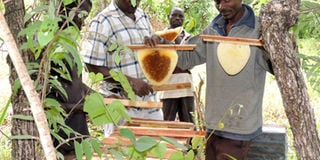Varroa mites: A threat to beekeeping

Bee keepers in Kamwenge District show dried empty honey combs. Research shows most beekeepers in Africa are unaware of the Varroa mite threat. PHOTO BY BRIAN SSENOGA.
What you need to know:
While beekeeping is increasing, there lurks a bee parasite whose effects could be far-reaching.
The steady increase in volumes of honey and other bee products from Africa could experience a significant downturn if a lot is not done to combat Varroa mite, a bee parasite that is spreading across the continent.
Varroa mite is an external parasite of brood and adult bees. It is a native parasite of the Asian honeybee, Apis cerana, spreads in almost all areas of beekeeping.
This is mainly through migratory beekeeping practices, shipment of queens, movement of colonies for pollination rentals, swarming bees and beekeepers getting in contact with already infested colonies. Its life cycle begins in sealed broods where it feeds and breeds.
Extent of the problem
In Tanzania, a study was carried out on status of the mite in East Africa. It revealed that several bee colonies in about 25 beekeeping areas are already infested. The study indicates that while most beekeepers were not aware of the problem, though about 48 per cent of the colonies are infested.
Issa Mpinga, a researcher at the Tanzania forestry services agency says, “The problem is not unique to Tanzania but the East Africa. It is even serious in South Africa, Egypt, Botswana, leading to considerable rate of bee mortality, and colony collapsing or absconding.”
“The invasive mites have spread to many areas irrespective of weather variability, altitudes or vegetation types. Its existence influences bee behavior and in the long run we might see a dramatic drop in hive products,” explains Mpinga, while refuting claims that varroa mite is only a problem to bees in either high-altitude areas or during cold weather.
Focus on management
According to the 2012 World Honey Report, global production of honey increased by 10 per cent from 1.4 million to 1.54 million metric tonnes (2005-2010). It also points out that large scale losses of honey bees due to various factors, including pests and diseases which began to occur in 2006 in major production zones across the world. This negatively affected global supply.
Alice Kangave, principal entomologist in the ministry of agriculture, reveals there is an ongoing study but samples picked from northern Uganda confirm the fears. She said, “Uganda is not exceptional but the impact of varroa mites is not seen on bees in the tropics as is the case in other countries. The problem only becomes intensive when bees are confined in one area and their activity is limited.
Naturally kept bee colonies are more resistant and can survive better. I think we should focus more on apiary management now because the reasons for bad bee health are multi-factorial.” Dr Wolfgang Ritter, a bee health expert, advises that good practice that follows the traditional beekeeping in Africa will help check the problem.
Some indicators
“Intensive operational methods practiced in many developed countries aim at avoiding swarming of colonies. No wonder that in those apiaries, you can find all kinds of possible diseases and pests yet by swarming, African bees get rid of varroa mite and dispose off hive beetles,” he explains.
However, experts warn that even when there are no signs of the effects on honey bees, farmers need to observe certain conditions. Weak colonies, high numbers of unoccupied hives, and poor colony performance could be some of the indicators.
Researchers found that varroa mites were present throughout Kenya. This is apart from the remote north and their numbers have increased. “Interestingly, studies show that while varroa infestation dramatically reduces colony survival in US and Europe, in Kenya, its presence alone does not appear to impact colony size,” notes Mary Warui, a bee health researcher.
Resilient
She points out that bee populations in Kenya have been experiencing decline in recent years. However, the common causes for colony losses in the West do not seem to be affecting Kenyan bees. “Preliminary data suggests that the loss of habitat and drought impacting flowering plants, from which the bees get all their food, may be the more important factor driving these declines but not pests like varroa mites,” she says.
Given their findings that African honey bees appear to be resilient, the experts recommended that beekeepers should maintain healthy bee populations. In addition to the careful use of pesticides, this is by protecting vital nesting habitat and the flowering plant diversity that the bees depend on for food.




